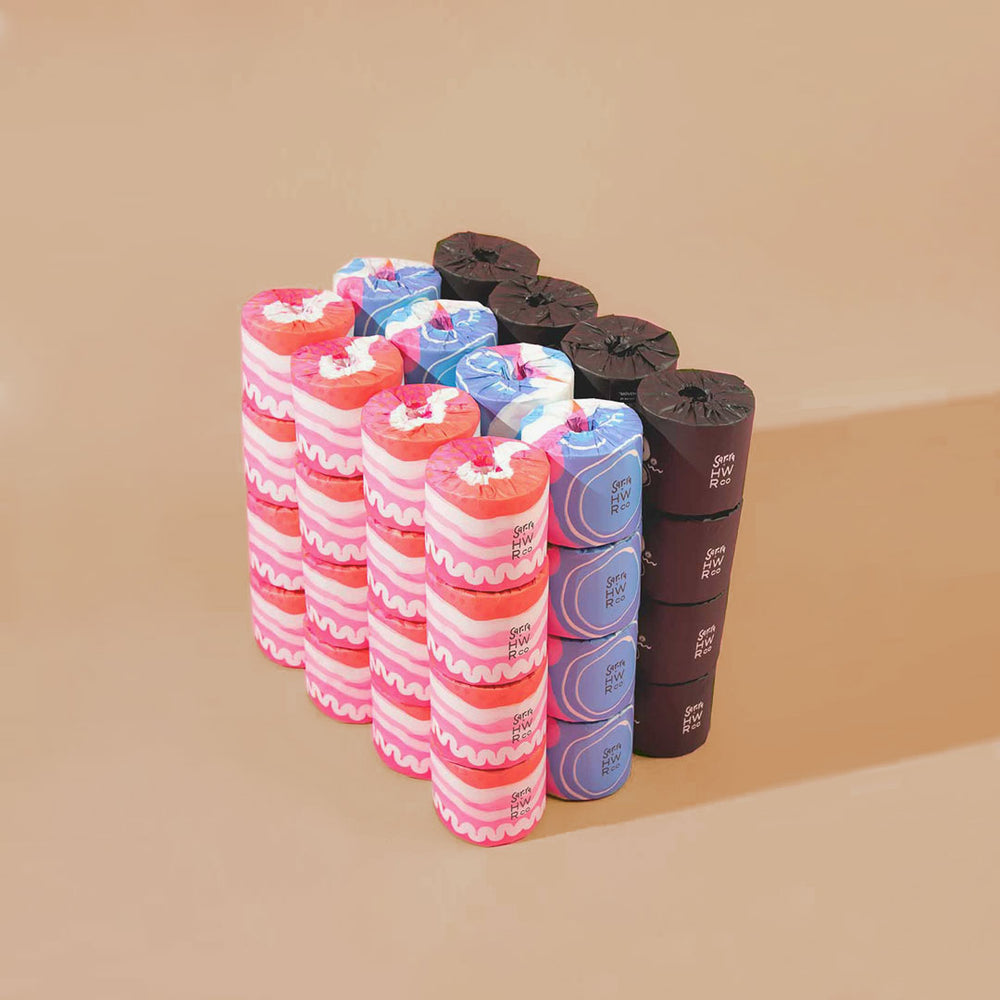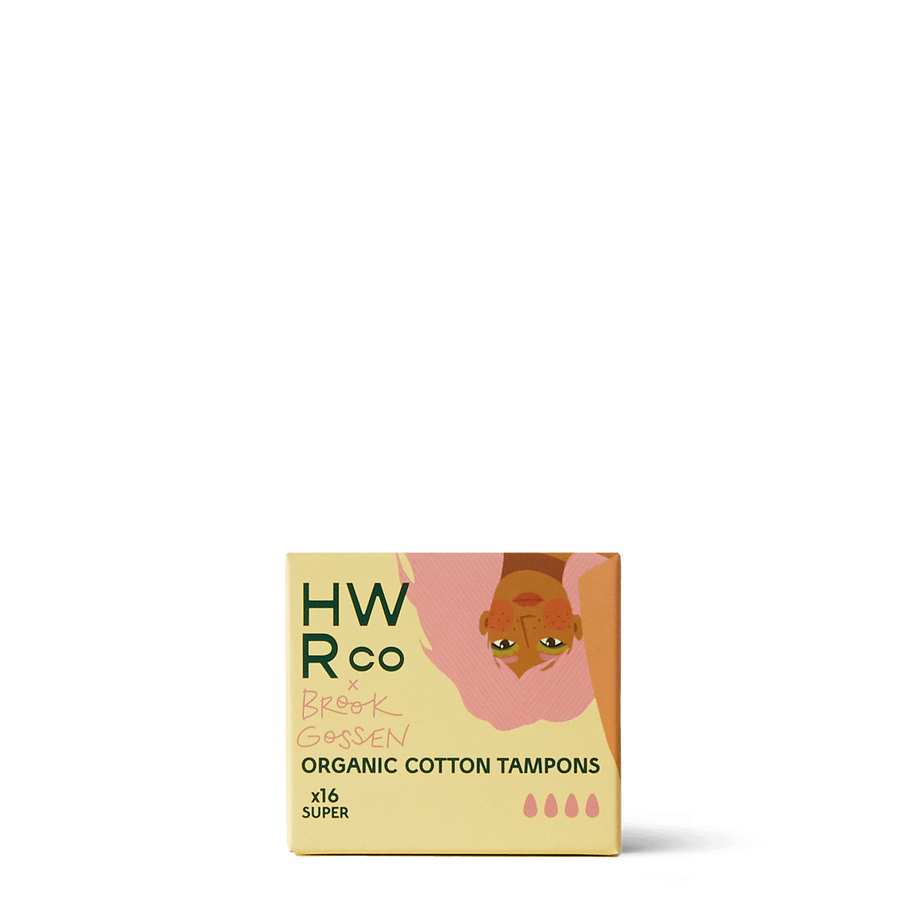Rolling with Rachael Sarra
We've been holding this one in for a while now, it was starting to get uncomfortable 😂 We're so excited to launch our local artist collab with Contemporary Aboriginal Artist Rachael Sarra from Goreng Goreng Country, on our box of 48, 100% Recycled Toilet Paper. Each box sold contributes to The Bridging The Gap Foundation, which aims to improve and advance the lives of Indigenous Australians.
We had a D&M with Rachael in the bathroom to find out more about her as an artist and how she uses art to educate and share Aboriginal culture and it’s evolution.

Tell us a little bit about yourself, where you grew up and how you became an artist?
My story is one that a lot of people can probably see themselves in actually. I am a mixed race, Aboriginal woman. On my fathers side, my grandmother was an Aboriginal woman and my grandfather was Italian. He came over to Australia after the war and his wife and family were supposed to meet him here but they never ended up making it over. He met my Grandmother and they have 10 children. On my mothers side, her family would identify as Australian, though they have french, English and Irish ancestry. We found out that my mothers side of the family came over to Australia as convicts. Which leads me into my story. I'm a product of who has come before me and my mixed race has caused me a lot of confusion around my identity, who I am and where I belong. I guess that's my story. I am uniquely me. I'm not perfect but I am unique, just like we all are. That's one thing my Dad has taught me. For me, the internal conflict of feeling too black to be white and not black enough to be black is not uncommon. I think it's something most of us have grappled with in our lives. But that's why art became so important to me. I graduated from the Queensland College of Art with a Bachelor of Design - Visual Communication design and even throughout that process I didn't know what role it would play. But as I started to connect my culture to my art and design that's when Art became an outlet for me to belong somewhere. I belonged in my artwork, the energy and emotions are intrinsically linked to my experiences so it's been a place where I could feel peace.
What was one piece of advice that someone gave you that you can pass on to someone growing up and inspire them to become an artist?
I can't remember what friend said this to me but essentially Governments will never adequately fund the creative industry because they are scared that artists will be able to create more change than what they do. For me I think that really reframes the power of art and design. It's not just pretty pictures but it's visual communication, powerful communication and human connection. Art and design is such a vehicle for change and it's a style of communication that is different. There isn't a right answer or a calculated way to get from A to B. It's open to interpretation.
How does your heritage influence your artwork?
To me my heritage is my art and art has always been part of my heritage. They are one the same. I take so much inspiration from my traditional heritage but I connect it to who I am today and every day. My identity will always be an evolution and my art is a way for me to preserve and nurture that connection. It may look different to the past but it is cut from the same cloth. I'm standing on the shoulders of my ancestors and doing my very best to exist in this modern world.

What role does the environment play in your artwork?
Caring for Country is so important. We see country, we hear country, we are country. Our ancestors spirits are everywhere and we need to care for them. They create the beautiful contours of the land, they are the salt water that heals us, the are the leaves rustling in the wind. I am constantly inspired by the environment consciously and subconsciously.

How does your art represent what it means to be an Indigenous Australian?
I touched on it earlier, but it's an extension of who I am, who's come before me and who's still to come. It's storytelling and it's the preservation of our culture. We are diverse and a nation of nations. My work is just telling my own stories based off my experiences as a Goreng Goreng woman in a modern world.
Pink is a colour that is central to your artwork. Why is pink such a significant colour for you?
I've always been really into the psychology and theory of colours. Aside from pink being a personal favourite it also has a calming effect and can also be quite stimulating. They are two feelings I really like to surround myself with. It's also just a really cool colour and has kind of become my signature.
You do a lot of collaborations and partnerships with businesses and local councils, why did you choose to partner up with How We Roll and what other unique/exciting collaborations you have done?
When I was younger I didn't see who I was represented very often and as I got older a lot of people had preconceived ideas about what Aboriginal art should be. So I love to collaborate with cool people doing cool things and through those partnerships I'm able to show how our culture and our art is evolving. It's not about saying this is the only way, but it's about putting our art out there so that young mob can dare to dream for themselves. I've had the pleasure of working with some really cool people like Tourism Australia, Kmart Australia, Lush Uk and Aus and obviously How We Roll. But through these partnerships I've been able to see my art come to life in ways that I never imagine. I think it's through these partnerships that I personally will be able to create change.

How important are these collaborations with businesses like How We Roll to artists like yourself?
They are so important. For me personally, I believe it's these partnerships that have the most power to create change. Private businesses aren't governed by policies and procedures that don't serve us. So for me when you find a business like How We Roll who are environmentally friendly and open to collaboratively working with artists like myself it's not only the representation that matters but it's also about being able to care for country and create environments where mob feel culturally safe. These collaborations also allow us to exist individually outside of agencies so we can determine our own futures.
The three pieces of artwork you created for How We Roll tells a story, can you explain a little more about how the colour and patterns help narrate the story?

Generations - We are the product of our past as we navigate and path the way for our future. With each connection, we share knowledge and stories, radiating across generations creating strong foundations and a powerful sense of identity.
Where We Are Now - Where we are now, is not always where we will be. Our lives through all the ups and downs, create moments in time where we have to grow, adapt and change. As we shed our skins on our past experiences, we grow and evolve on our continuing journey.
Movement - Watch as our ancestors move and speak to us. Feel them in the breeze, hear them as the leaves ruffle in the branches. Heal from our ancestors as we place our feet into the sinking sand of the salt water. They are here with us, moving with us and supporting us.
For me these three stories tell a story of our connection to our culture, to our land and to our ancestors. Our connection isn't always physical but it's always present.
Toilet paper has been the most talked about product in 2020, how does it feel to never have to line up for toilet paper again?
Feels good to avoid at least one shitty situation and for the ones we can't avoid it's good to know at least the loo will look good
One of your Instagram posts that stood out is the 'Art Saves Lives' post. Can you explain a little bit more about that message?
I cannot stress this enough. Art does save lives. I truly believe that people just want to belong somewhere, they want to feel seen or heard. Maths, science etc all of those calculated ways of thinking are important and of course allow our futures to evolve and expand. But not everyone thinks that way. Art is for the individuals, it's just a flow on affect that people can see themselves in an artists work. For me, I just want to ask people "How many times do you need to do the same thing only to get the same results?" For me art is thinking differently, it's an emotive communication and it appeals to us all differently. It allows us to explore different paths and see where we end up rather than having a predetermined outcome. I think art is absolutely undervalued but incredibly important. I could do a whole other TEDtalk on this.

The pandemic has obviously caused a great deal of distress to the art community, what advice would you give to a local artist who is doing it tough at the moment?
Lean into it. I was incredibly lucky to not be overly affected by Covid (touch wood). But the beauty of art is that it is expressive. We can find solace, hope, motivation and peace in art. I think as artists we just need to 'be' sometimes. Take the pressure off and connect back to why we started.
For better or for worse, 2020 has been an eventful year, how has 2020 influenced or even changed you as an artist and your artwork?
I feel bad saying this, but I think 2020 was the year we needed to actually create some change. To understand our privilege and know what is important to us. Being here in Australia for the most part and for most of us we are quite protected from a lot of things and I think that really made us complacent. Now I think we have a better understanding on how precious life is and so hopefully our thinking extends in an equitable way. I think my art will always be an extension of this thinking.
We would like to acknowledge the Traditional Owners of the land and the sea on which we work and gather and pay our respects to Elders past, present and emerging.
Shop the toilet paper collab here
Rachael Sarra -
@sar.ra__
rachaelsarra.com












